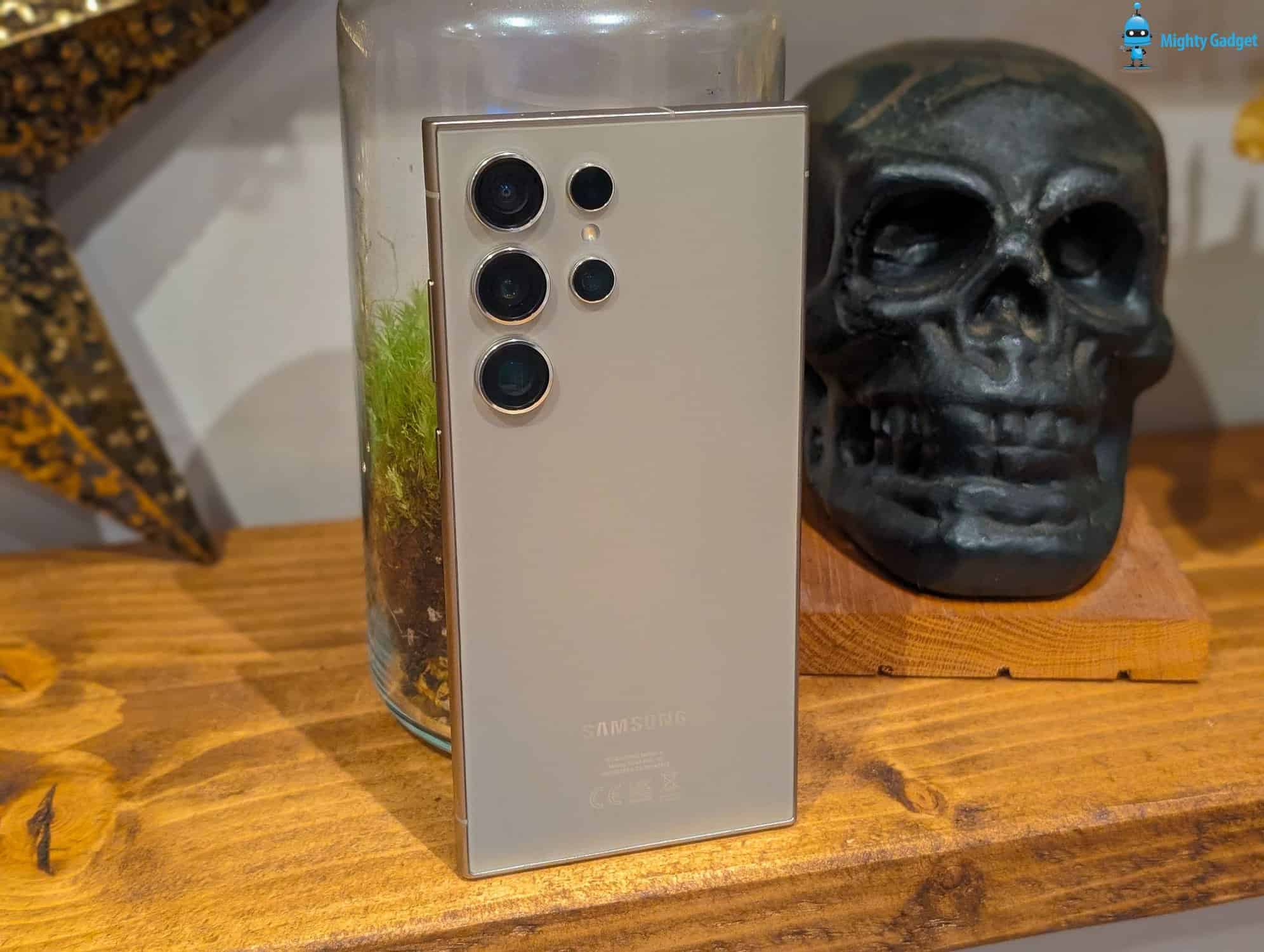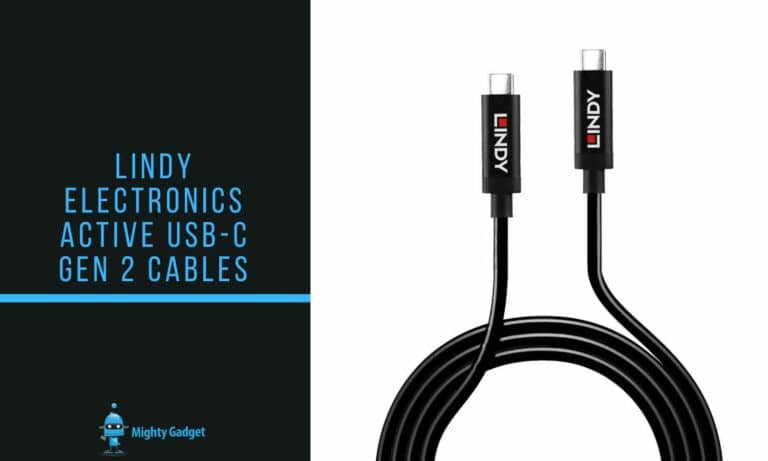Any links to online stores should be assumed to be affiliates. The company or PR agency provides all or most review samples. They have no control over my content, and I provide my honest opinion.
The Samsung Galaxy S24 Ultra was announced a couple of weeks ago and is inevitably going to be classed as one of the best, if not the best, flagship Android smartphones for 2024.
In previous years, Samsung would launch the Ultra with a Samsung Exynos chipset in Europe and a Qualcomm Snapdragon chipset in the US. Samsung would often be criticised for this because the Exynos chips based on the Samsung fabrication process were not as good as the Qualcomm counterparts.
Last year, Samsung dropped this strategy and used the Snapdragon 8 Gen 2 for all the S23 phones.
They have changed things again this year, the S24 Ultra gets Qualcomm globally, but the S24+ and S24 use the Snapdragon in the US but Exynos 2400 internationally. Personally, I think it would have made more sense to use the Exynos 2400 for all the S24/24+ phones (or maybe just the 24), as this would inevitably avoid criticism for using different chipsets in different regions. It is also more acceptable to use an inferior chipset on one of the more affordable models.
Regardless, I am glad that all the S24 Ultra models have the Snapdragon 8 Gen 3, and if anyone is going to make the most of all the AI features of this chipset it is Samsung.
I have previously reviewed the iQOO 12, which was one of the first phones to launch with the SD8 Gen 3, but I think this comparison is worthwhile as it is the Samsung Galaxy S24 Ultra is typically the bestselling flagship phone of the year and should give a more accurate idea of the performance than a lesser-known Chinese brand.
The previous two phones I used long term were the Pixel 8 Pro and Honor Magic5 Pro, so I will make a lot of comparisons to them.
Qualcomm Snapdragon 8 Gen 3 vs Snapdragon 8 Gen 2 Specification
| Qualcomm Snapdragon 8 Gen 3 | Qualcomm Snapdragon 8 Gen 2 | Google Tensor G3 | |
|---|---|---|---|
| Process | TSMC 4nm (N4) | TSMC 4nm (N4) | Samsung 4nm |
| CPU | 1x Kryo (ARM Cortex X4-based) Prime core @ 3.3GHz 3x Kryo (ARM Cortex A720-based) Performance cores @ 3.2GHz 2x Kryo (ARM Cortex A720-based) Performance cores @ 3.0GHz 2x Kryo (ARM Cortex A520-based) Efficiency cores @ 2.3GHz | 8-Core 1× Cortex-X3 (3.2 GHz) 4× Cortex-A715 (2.8 GHz) 3× Cortex-A510 (2.0 GHz) | 9-Core 1x Arm Cortex-X3 (2.91GHz) 4x Arm Cortex-A715 (2.37GHz) 4x Arm Cortex-A510 (1.70GHz) |
| GPU | Adreno 750 (claimed 50% faster) | Adreno 740 | Arm Immortalis-G715 |
| Caches | 12MB L3 cache | 8 MB level 3 cache | Unknown |
| RAM | LPDDR5X @ 4800MHz | LPDDR5X @ 4200MHz | LPDDR5 @ 5500MHz |
| Machine Learning | Hexagon DSP with Hexagon Vector eXtensions, Hexagon Tensor Accelerator, Hexagon Scalar Accelerator, Hexagon Direct Link (Claimed 98% faster AI performance 40% performance per watt improvement) | Qualcomm Hexagon | Third-gen Tensor Processing Unit |
| Media Decode | H.264 (AVC), H.265 (HEVC), VP8, VP9, 4K HDR10, HLG, HDR10+, Dolby Vision, AV1 | H.264, H.265, VP9, AV1 | H.264, H.265, VP9, AV1 |
| Modem | Snapdragon X75 5G Modem Downlink: 10Gbps Uplink: 3.5Gbps mmWave: 8 carriers, 2x2 MIMO sub-6 GHz: 4x4 MIMO | 4G LTE 5G sub-6Ghz and mmWave | 4G LTE 5G sub-6Ghz and mmWave |
| WiFi | Qualcomm FastConnect 7800; Wi-Fi 7, Wi-Fi 6E, Wi-Fi 6; 2.4/5GHz/6GHz | WiFi 7 | WiFi 7 |
| Bluetooth | Bluetooth: Version 5.4, aptX Voice, aptX Lossless, aptX Adaptive, and LE audio | 5.3 | 5.3 |
Antutu V10 Benchmark
| Antutu | Total | CPU | GPU | MEM | UX |
|---|---|---|---|---|---|
| Snapdragon 8 Gen 3 iQOO 12 | 2084308 | 446149 | 906269 | 400131 | 331759 |
| Snapdragon 8 Gen 3 Samsung Galaxy S24 Ultra | 1945797 | 445818 | 817997 | 373210 | 308772 |
| Snapdragon 8 Gen 2 Honor Magic5 Pro V10 | 1367374 | 298680 | 583069 | 259642 | 225983 |
| Google Tensor G3 Pixel 8 Pro V10 | 1144447 | 355374 | 381544 | 177818 | 229711 |
| Dimensity 8200-Ultra Xiaomi 13T V10 | 896827 | 260471 | 230211 | 192345 | 213800 |
| MediaTek Dimensity 8100 Realme GT Neo 3 V10 | 871235 | 260194 | 215150 | 180938 | 214956 |
| Google Tensor G2 Pixel 7 Pro V10 | 848876 | 231239 | 289398 | 141067 | 187172 |
| Google Tensor Pixel 7 6 V10 | 845450 | 249800 | 236824 | 157931 | 200895 |
| MediaTek Dimensity 8050 Infinix Note 30 VIP V10 | 732420 | 205125 | 184374 | 158126 | 184795 |
The Antutu benchmark starts the trend of the Samsung Galaxy S24 Ultra scoring less than the iQOO 12. The S24’s firmware and One UI software will be optimised differently and likely favour efficiency over peak performance, but I haven’t had the phone long enough to confirm how much better the battery life is.
Samsung is only 6.6% behind the iQOO, which is unlikely to translate to any real-world performance differences.
The CPU result is almost identical, but the GPU result is almost 10% lower and the UX result is 7% lower.
In comparison to the Snapdragon 8 Gen 2 on the Honor Magic5 Pro and the Google Tensor G3 on the Pixel 8 Pro, the SD8 Gen 3 has a massive advantage. This is particularly embarrassing for Google as the Pixel 8 Pro was only launched in October.
In comparison to the Magic5 Pro with the SD8 Gen 2, the Samsung scores 42% higher.
In comparison to the Pixel 8 Pro, the Samsung scores 70% higher!
Geekbench 6 Benchmark
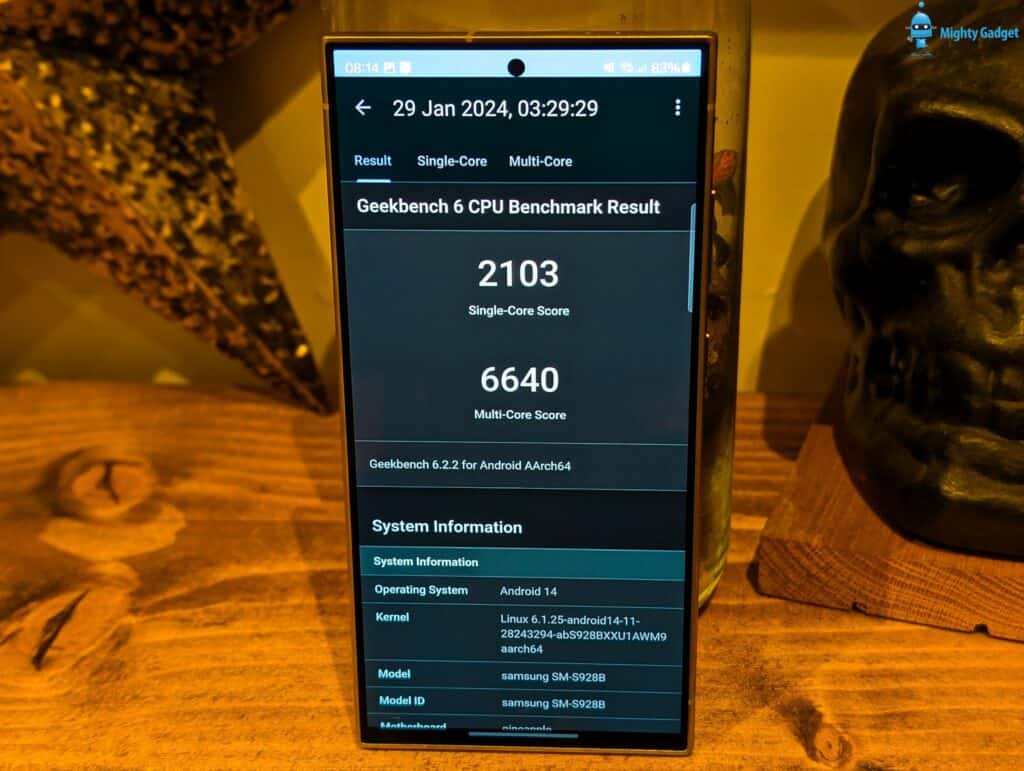
| Chipset | Single Core | Multi Core |
|---|---|---|
| Snapdragon 8 Gen 3 iQOO 12 | 2250 | 6909 |
| Snapdragon 8 Gen 3 Samsung Galaxy S24 Ultra | 2103 | 6640 |
| Snapdragon 8 Gen 2 | 1949 | 5235 |
| Tensor G3 | 1763 | 4409 |
| Tensor G2 | 1410 | 3410 |
| Tensor | 1264 | 3283 |
| Dimensity 8200-Ultra | 1119 | 3733 |
The trend continues with Geekbench 6. Samsung is 6.5% and 3.9% behind iQOO for single and multiple cores, respectively, but again, this is unlikely to have much impact on real-world experiences.
Things are reasonably close with the SD8 Gen 2, with the Gen 3 scoring 7.9% and 26.8% higher.
The multi-core result has a big jump because Qualcomm has switched up the chipset design this year; there are now only two Cortex A520-based efficiency cores vs three from the SD8 Gen 2. This then gives five Cortex A720-based cores, three of which are clocked at 3.2GHz and two at 3.0GHz vs four at 2.8 GHz from last year.
In comparison to the Tensor G3, the SD8 Gen 3 on the Samsung archives a result that is 19.3% and 50.6% higher, respectively.
3DMark Wildlife Stress Testing / Thermal Throttling Benchmark
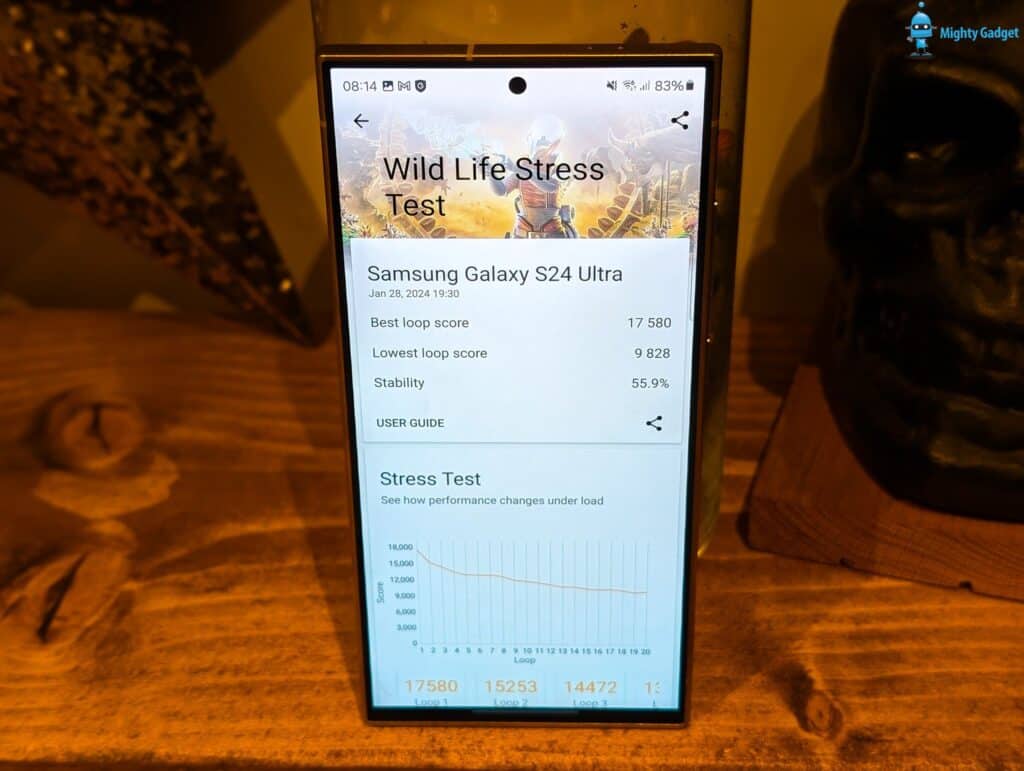
| 3DMark | Chipset | Wild Life High | Wild Life Low | Stability | Temperature | Battery |
|---|---|---|---|---|---|---|
| iQOO 12 Retest | Snapdragon 8 Gen 3 | 18346 | 12144 | 66.2% | 26° to 42° | 87% to 73% |
| iQOO 12 First Test | Snapdragon 8 Gen 3 | 18087 | 7549 | 41.7% | 25° to 39° | 96% to 82% |
| Samsung Galaxy S24 Ultra | Snapdragon 8 Gen 3 | 17580 | 9828 | 55.9% | 24° to 42° | 79% to 66% |
| Honor Magic5 Pro | Snapdragon 8 Gen 2 | 12726 | 8567 | 67.3% | 19° to 38° | 100% to 92% |
| Honor Magic4 Pro | Snapdragon 8 Gen 1 | 10189 | 6445 | 63.3% | 24° to 44° | 86% to 72% |
| OPPO Find X5 Pro | Snapdragon 8 Gen 1 | 9537 | 6060 | 63.5% | 21° to 44° | 33% to 23% |
| Pixel 8 Pro | Google Tensor G3 | 8434 | 5599 | 66.4% | 27° to 44° | 83% to 72% |
| Pixel 7 Pro | Google Tensor G2 | 6527 | 4766 | 73% | ||
| Pixel 6 | Google Tensor | 6908 | 3487 | 50.5% | ||
| Xiaomi 13T | Dimensity 8200-Ultra | 6485 | 5879 | 90.7 | 28° to 42° | 83% to 74% |
| OnePlus 9 Pro | Snapdragon 888 | 5775 | 3489 | 60.3% | ||
| OPPO Find X3 Pro | Snapdragon 888 | 5765 | 3804 | 66% | ||
| Samsung Galaxy S21 Ultra | Exynos 2100 | 5466 | 6404 | 62.3% | ||
| Xiaomi Mi 11 | Snapdragon 888 | 5550 | 5045 | 90.9% | ||
| Realme GT | Snapdragon 888 | 5850 | 3234 | 55.3% | ||
| Oppo Find X3 Neo | Snapdragon 865 | 5038 | 4942 | 98.1% | ||
| Realme GT Neo 3 | Dimensity 8100 | 5446 | 5399 | 99.1% | 32° to 38° | 100% to 94% |
| Infinix Note 30 VIP | Dimensity 8050 | 4565 | 4506 | 98.7 | 31° to 46° | 100% to 91% |
| OnePlus Nord 2 | Dimensity 1200 | 4161 | 2932 | 70.5% |
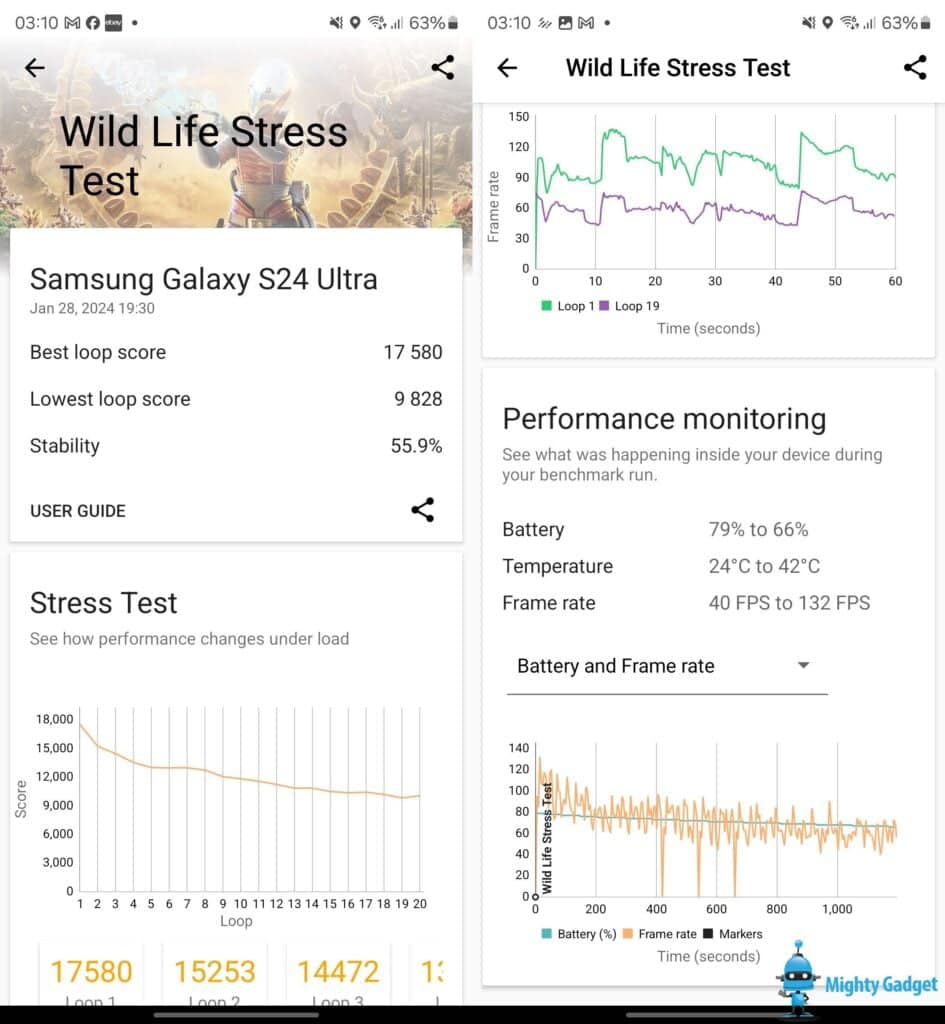
I had some issues with testing the iQOO 12, and the results were inconsistent.
For Samsung, it is 4% and 19% below the results I achieved with the iQOO on the retest.
Some napkin maths indicates that Samsung used roughly 650mAh of battery vs 700mAh on the iQOO which backs up my theory that Samsung has favoured efficiency over peak performance.
Samsung achieves a result that is 38% higher for the high score and 14.7% higher for the low score. The Honor Magic5 Pro dropped just 8%pt, which is roughly 408mAh.
Looking at the table, the Honor started at a much lower temperature which will likely have given it an advantage.
GFXBench

GFXBench does a wide number of tests that make it a bit long-winded to do comparisons. For this article, I am just posting the screenshots of the Samsung Galaxy S24 Ultra results so that I can use them for comparisons in the future.
AI Benchmarks
With every company obsessed with AI and chipset manufacturers placing increased focus on AI, I started to add AI benchmarks with the Pixel 8 Pro.
AI benchmarks can vary wildly due to the AI libraries that get used. The Google Tensor G3, uses the Android Neural Networks API (NNAPI) that is built into Android.
Qualcomm chipsets have their own neural network library, and the problem here is that a developer needs to apply to Qualcomm to be allowed to use it. This ends up meaning the Snapdragon 8 Gen 2 can perform significantly better than the Tensor G3 if the application has access to those libraries.
AI Benchmark
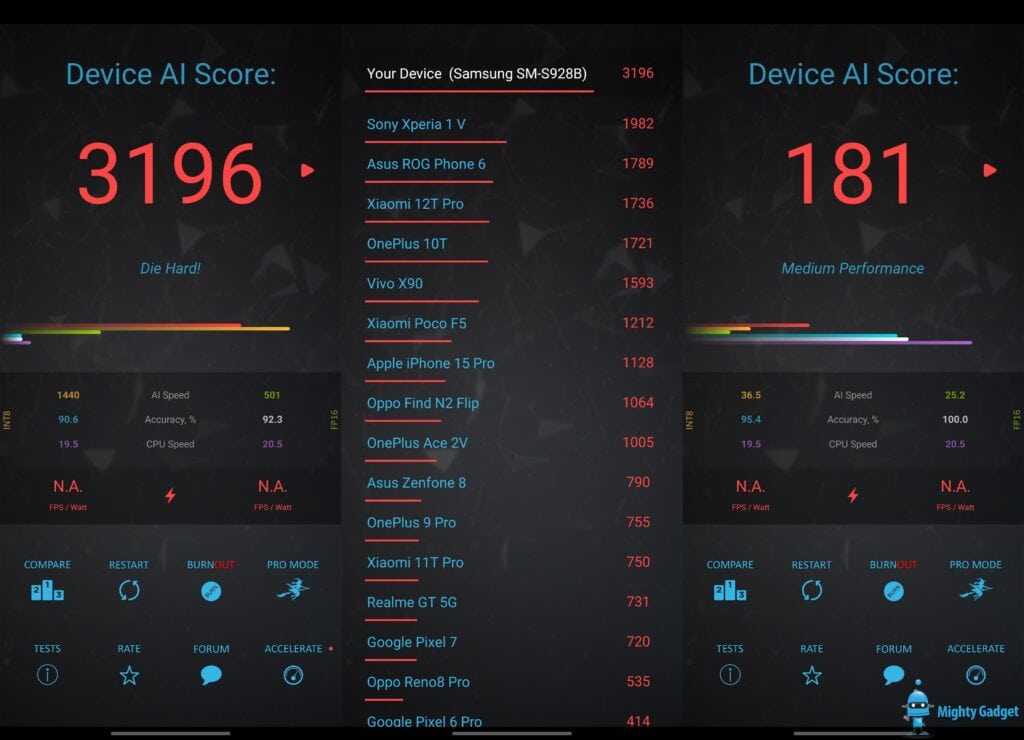
- Samsung Galaxy S24 Ultra with Qualcomm Snapdragon 8 Gen 3 using the default Qualcomm libraries: 3196
- iQOO 12 with Qualcomm Snapdragon 8 Gen 3 using the default Qualcomm libraries: 3168
- Honor Magic 5 Pro using Qualcomm Libraries: 1870
- Pixel 8 Pro: 718
- Pixel 6: 337
- Samsung Galaxy S24 Ultra using NNAPI: 181
- Honor Magic 5 Pro using NNAPI: 135
Geekbench ML

- Pixel 8 Pro:
- CPU: 2122
- GPU: 702
- NNAPI: 2827
- Pixel 6: 1989
- Samsung Galaxy S24 Ultra :
- CPU: 1227
- GPU: 1259
- NNAPI: 667
- Honor Magic 5 Pro: 562
I wasn’t able to run Geekbench ML when I tried it with the iQOO 12 but is ran fine with the Samsung.
The Pixel 8 Pro using the Tensor G3 finally gets a win with a result that’s 73% higher than the SD8 Gen 3. Even the original Tensor chipset scores 62% higher than the SD8 Gen 3.
That being said, Qualcomm has made big improvements since last year, achieving a result that’s 118% higher than the SD8 Gen 2.
I then also ran the test using the GPU and NNAPI options. Samsung achieves almost the same result with the GPU option but doesn’t make the most of the Android Neural Networks API (NNAPI), unlike the Pixel, which seems to have a significant improvement in performance when using NNAPI.
Overall
When I tested the Qualcomm Snapdragon 8 Gen 3 with the iQOO 12, I had already established that it is an incredible chipset.
While the Samsung score is lower than the iQOO, the results are close enough that I doubt you would see any significant real-world performance differences.
The Samsung appears to use less battery than the iQOO, and I would say that you are more likely to notice a 7-10% improvement in battery capacity than raw performance.
For the past few years, I have stated that flagship chipsets have more than enough performance for the vast majority of people’s needs, and I feel that most of these big benchmark numbers are meaningless in most scenarios as we rarely make the most of the processing power.
For me, battery life has always been incredibly important; I am possibly traumatised by many older phones that would need charging halfway through the day. However, with both the Pixel 6 Pro and Pixel 8 Pro, I have found the battery to be quite poor. I’d often need to charge the Pixel 8 Pro in the afternoon if I was using it a lot, but the Honor Magic5 Pro would consistently make it through most days easily.
The Google Tensor chipsets have been produced on the Samsung fabrication process which has always been less power efficient than TSMC.
It is too early to tell how good the battery is for the S24 Ultra, but has done better than my Pixel so far.
I am James, a UK-based tech enthusiast and the Editor and Owner of Mighty Gadget, which I’ve proudly run since 2007. Passionate about all things technology, my expertise spans from computers and networking to mobile, wearables, and smart home devices.
As a fitness fanatic who loves running and cycling, I also have a keen interest in fitness-related technology, and I take every opportunity to cover this niche on my blog. My diverse interests allow me to bring a unique perspective to tech blogging, merging lifestyle, fitness, and the latest tech trends.
In my academic pursuits, I earned a BSc in Information Systems Design from UCLAN, before advancing my learning with a Master’s Degree in Computing. This advanced study also included Cisco CCNA accreditation, further demonstrating my commitment to understanding and staying ahead of the technology curve.
I’m proud to share that Vuelio has consistently ranked Mighty Gadget as one of the top technology blogs in the UK. With my dedication to technology and drive to share my insights, I aim to continue providing my readers with engaging and informative content.

